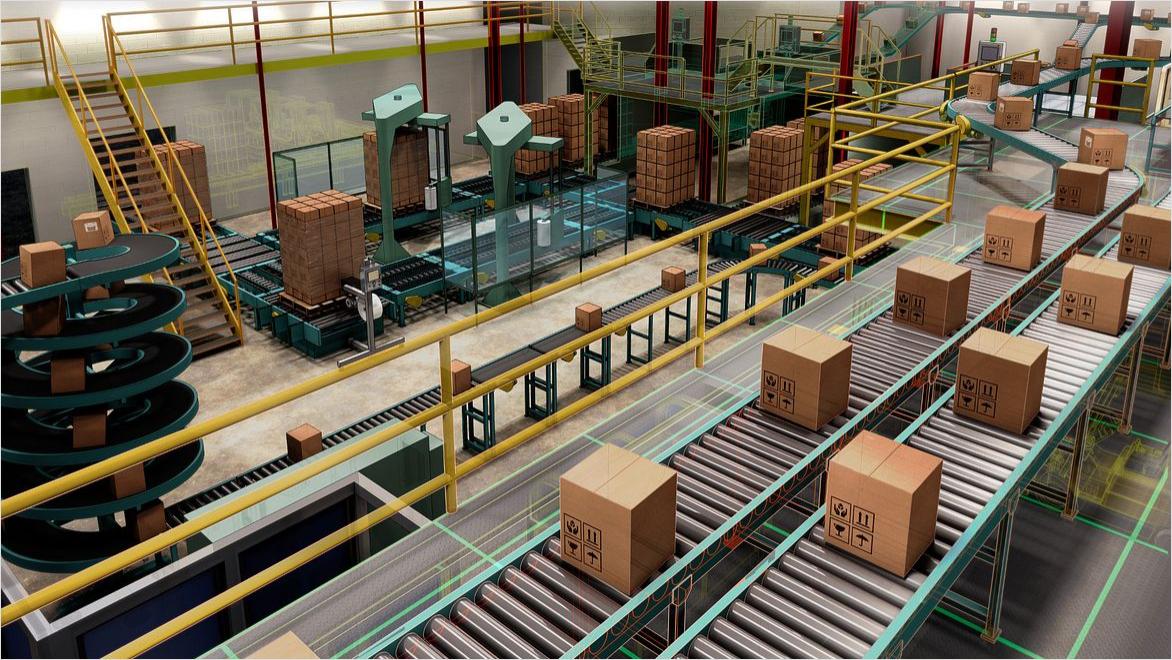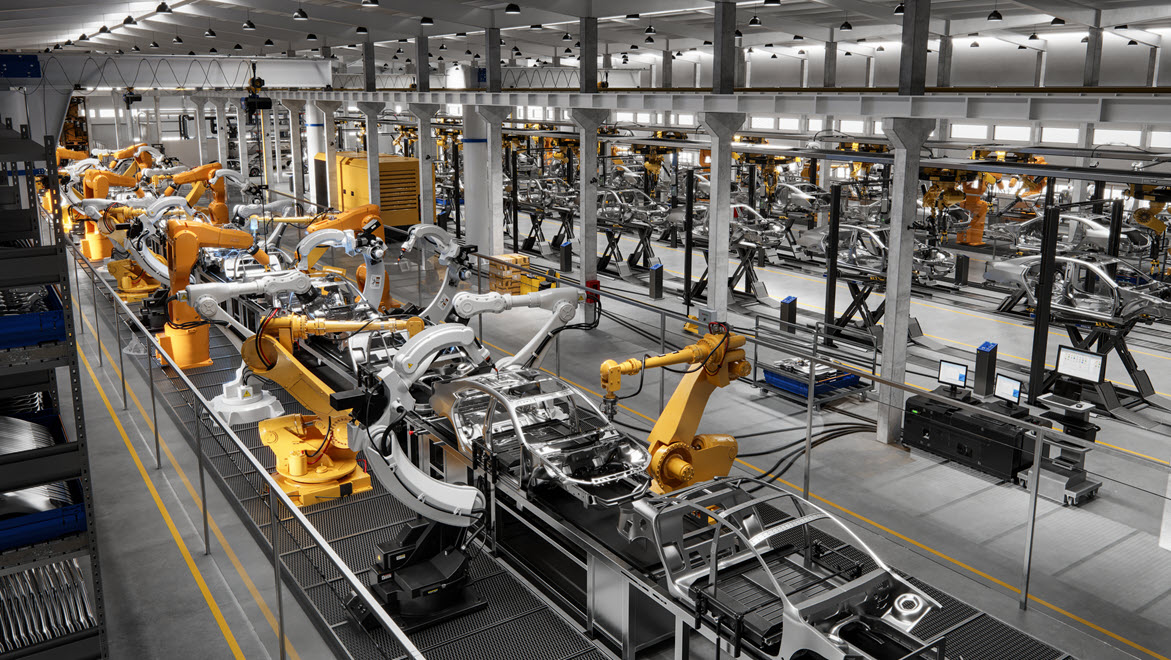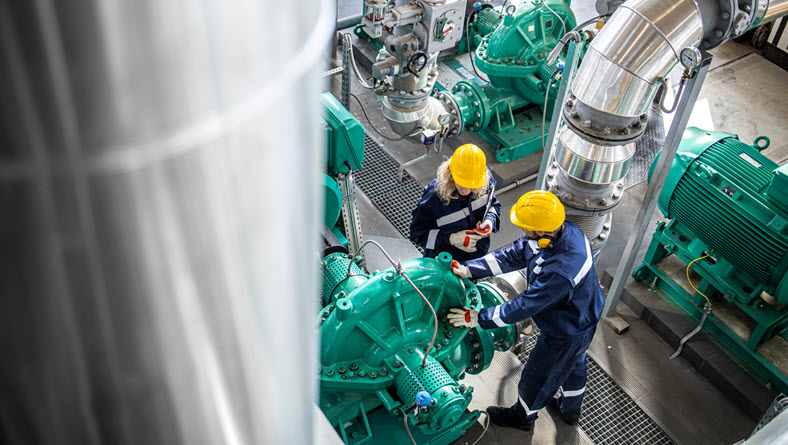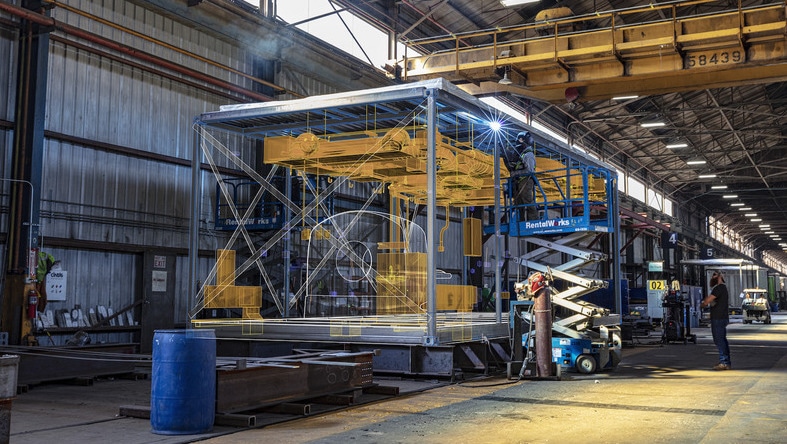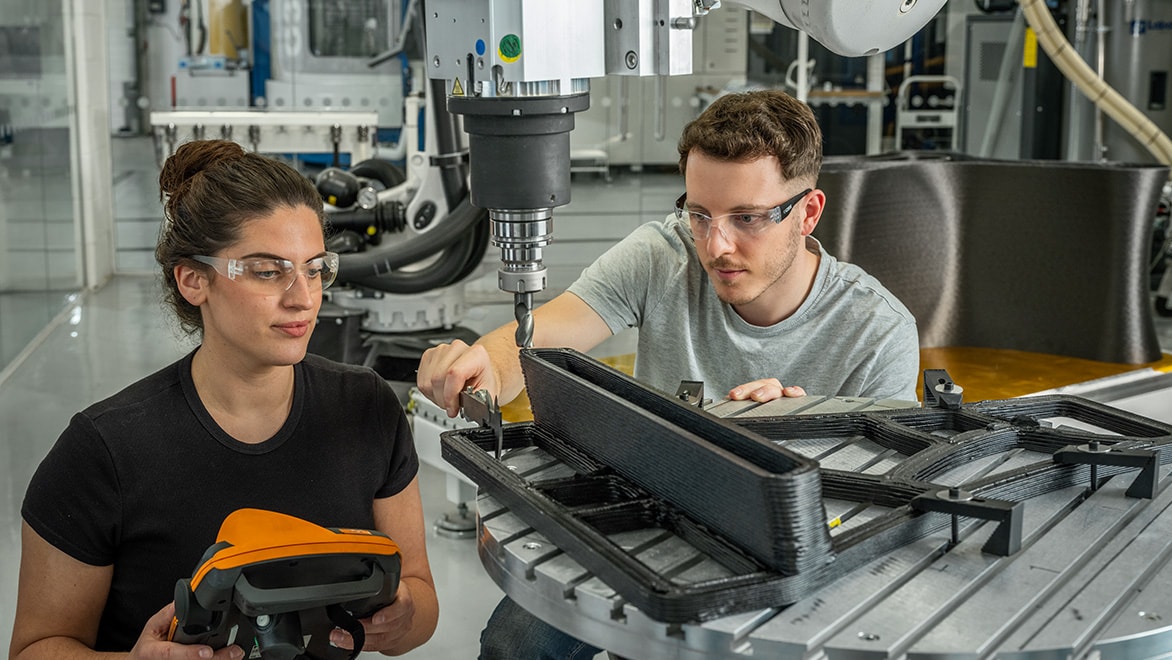& Construction

Integrated BIM tools, including Revit, AutoCAD, and Civil 3D
& Manufacturing

Professional CAD/CAM tools built on Inventor and AutoCAD
Imagine a world where machines work tirelessly, precisely, and safely to create the products we use daily. Industrial automation is an approach that helps make this a reality by rethinking how we manufacture and process goods.
The industrial automation process uses technologies like robotics, sensors, and smart control systems to carry out tasks once done by human hands. These solutions are helping industries across the board, from cars rolling off assembly lines to carefully packaged pharmaceuticals. The approach helps many businesses deliver consistently high-quality products, improve their workplace safety, become more productive, and reduce their long-term costs.
The seeds of industrial automation were planted back in 1913 when Ford’s Model T assembly line sparked a manufacturing revolution. However, the true dawn of industrial automation came in 1968, when General Motors introduced the programmable logic controller (PLC).
PLCs are the initial brains behind industrial automation. These devices can monitor multiple machines simultaneously, execute complex, pre-programmed instructions, and adapt to changing production needs.
GM’s pioneering use of PLCs in car manufacturing paved the way for today’s smart factories and set the stage for an exciting future where data guides our manufacturing processes.
Industrial automation software helps enhance efficiency and productivity in manufacturing and other industrial operations. It allows companies to automate complex processes, reducing the need for manual intervention and minimizing human error. By streamlining operations, industrial automation software helps businesses achieve higher throughput and consistency in production. This leads to improved product quality and reduced cycle times.
Industrial automation software also helps reduce costs and improve resource management. Companies can significantly cut down on labor costs and reduce material waste by gaining the ability to automate repetitive tasks and optimize resources. It also enables predictive maintenance by analyzing data from equipment sensors. Manufacturers are able to predict potential failures and schedule timely maintenance to prevent costly downtime. Industrial automation software also supports scalability. Businesses can grow and adapt to changing demands, while expanding operations without substantial investments in new infrastructure.
While industrial automation comes with a high initial investment, its long-term benefits make it a smart choice for manufacturers in all industries.
Industrial automation software unlocks the potential to run a factory 24 hours a day, 365 days a year. With real-time data analysis, automated systems can minimize production bottlenecks and downtime through predictive maintenance while keeping your inventory in check.
Automated manufacturing ensures a high level of consistency by catching variations early through automated quality control. This validation reduces waste and the need for your team to rework.
Robotic and other industrial automation can take over the dangerous, repetitive tasks humans do. Such delegation lowers the risk of injuries and enables your employees to focus on more complex and rewarding work.
Monitoring devices gather data in real-time throughout the industrial automation process. This up-to-the-minute information helps streamline your supply chain, uncover new revenue opportunities, and inform better decision-making.
Industrial automation software can be quickly reprogrammed if needed, meaning you can make swift changes on the assembly line that meet your evolving needs.
Despite upfront costs, running operations 24/7 with minimal human oversight and lower maintenance costs leads to significant savings over time. The investment in industrial automation software will quickly be worth it.
Powerful product design and engineering tools for 3D mechanical design, simulation, visualization, and documentation.
Industrial automation software aids the creation and management of automated control systems for machinery and processes. This includes programmable logic controllers (PLCs) and distributed control systems (DCS) for precision and uninterrupted operations.
Industrial automation software offers real-time monitoring and data analytics capabilities. Operators are able to track performance, detect anomalies, and optimize processes. This helps in improving efficiency and predicting maintenance needs.
Industrial automation software is designed to integrate seamlessly with various hardware and software systems. This includes sensors, actuators, enterprise resource planning (ERP) systems, and manufacturing execution systems (MES) for smoother communication across the manufacturing process.
Advanced simulation and modeling tools give engineers the ability to design, test, and validate automation systems in a virtual environment before implementation. This reduces the risk of errors and promotes optimal system performance.
Industrial automation software is highly scalable. Businesses can expand their operations and add new processes without significant changes to the existing infrastructure. This flexibility supports growth and agility to address changing market demands.
Predictive maintenance tools use advanced analytics and machine learning to monitor equipment health and predict potential failures. This allows businesses to schedule optimal maintenance activities, reducing unplanned downtime and minimizing costs.
Early industrial automation mostly focused on boosting productivity through 24/7 operations and reducing human workforce costs. But as technology advanced, so did our ambitions. We can see this progression through the different stages and types of industrial automation.
Fixed industrial automation systems operate around the clock, following a set workflow designed for high-volume production. This setup makes fixed systems ideal for industries like food service and large-scale manufacturing, where consistency and output are important. However, while the process is efficient, making any changes to the production can be costly and time-consuming. Fixed automation can also be quite rigid—businesses must carefully plan for future growth or shifts in demand and determine if this approach can keep up.
Programmable industrial automation, mostly used in batch production, allows for electronic controls that can adjust machine configurations and operations sequences. Although this flexibility is a step up from fixed automation, making changes requires considerable time and planning. It’s a great option for businesses needing some adaptability. But again, the process isn’t instant when your production needs change.
Flexible industrial automation, including various classes of Computer Numerical Control (CNC) machines, is ideal for both on-demand and off-demand production. The systems provide precise controls, enabling you to customize your options more than other automation types. You can make quick changes, minimize downtime, and keep production efficient and adaptable—useful for industries that need both flexibility and speed in their operations.
Integrated automation is the most comprehensive industrial automation system, connecting machines, production lines, and equipment under a single control system. It’s an important part of Industry 4.0 and 5.0, which focus on using smart technology and increased human-machine collaboration. With Industrial Internet of Things (IIoT) devices collecting data at each step, cloud-based analysis enables automated decisions in production, supply chain, and workforce management. These devices can also enhance other automation types to make them more data-driven and efficient.
Most industrial automation processes start with sensing and data collection. Sensors and devices gather real-time data on the temperature, pressure, speed, and position of production lines and other environments.
The collected data is then analyzed using control systems or industrial computers. These systems make decisions based on predefined parameters, such as the best operating conditions or safety thresholds.
Based on the processed data, instructions are sent to machines—like robots or motors—to adjust manufacturing actions. This might include starting or stopping a process, changing the speed, or fine-tuning other areas of your operation.
These machines can then continue working autonomously without human input. Manufacturers can continuously monitor performance and adjust their industrial automation system as needed, ensuring it’s always efficient, reliable, and can adapt to your changing business.
Automotive manufacturers use industrial automation software for precision manufacturing, assembly line automation, and quality control. It also improves efficiency in processes such as welding, painting, and part assembly for consistency and reduced production times.
Industrial automation software manages complex manufacturing processes, keeping everything in line with strict regulatory standards. It facilitates precise mixing, packaging, and labeling, while improving traceability and data integrity for quality assurance.
The food and beverage industry is able to optimize production lines, from ingredient mixing to packaging and labeling with industrial automation software. This aids in improving product quality, improves safety standards, and increases throughput by streamlining repetitive tasks.
Industrial automation software is used for monitoring and controlling drilling operations, refining processes, and pipeline management. It improves safety, enhances operational efficiency, and supports predictive maintenance to prevent equipment failures.
Industrial automation software supports the detailed processes involved in semiconductor fabrication and electronics assembly. It boosts precision, reduces human error, and increases production speed, meeting the high demand for electronic components.
In the chemical industry, industrial automation software is used for complex manufacturing processes with strict regulatory standards. It aids in precise mixing, packaging, and labeling, while improving traceability and data integrity.
Discover how Autodesk customers use our industrial automation software to help their processes thrive.
Viessmann
To serve the booming German heat pump market, Viessmann built a smart factory with a high degree of industrial automation that increases production and improves logistics.
Image courtesy of Viessmann
Porsche
Porsche used digital factory planning in Autodesk Navisworks for its first fully electric sports car to build a state-of-the-art, zero-impact facility. The factory leans on industrial automation, such as driverless transport systems, to maximize production flexibility.
Image courtesy of Dr. Ing. h.c. F. Porsche AG
BLOX
BLOX employs industrialized construction—the application of offsite manufacturing automation—to build hospital components in its Alabama factory for onsite assembly.
Industrial automation software is used to control, monitor, and optimize industrial processes. Here are some key applications of industrial automation software:
The future of industrial automation software is poised for exciting advancement. Changes will be driven by emerging technologies (such as artificial intelligence and machine learning) and an increasing demand for efficiency.
As systems become more integrated, industrial automation software will automate tasks, better predict maintenance needs, and adapt to quickly changing environments. Collaborative robots—or cobots—are set to play a major role. They’ll work alongside humans to be more productive and help create safer workplaces.
We’ll continue to see more ‘smart factories’, which are facilities where all the machines communicate with each other, leading to more efficient operations and better resource management. Access to more data will mean deeper insights into production trends and performance—manufacturers can make faster, more impactful decisions. Businesses will become more agile and able to meet ever-changing market demands.
Read how the digital factory’s industrial automation processes and connected data will define manufacturing’s future, offering a faster time to market, predictive maintenance, resource tracking, and operational efficiencies.
Learn about highly digitalized and connected smart factories, why their automated systems and decision-making are essential for modern manufacturing, and the software that can help you work smarter, not harder.
This infographic shows why a successful smart factory transformation starts with convincing managers and executives that automating repetitive processes reduces errors, minimizes injuries and waste, and improves resource use and product quality.
The Smarter Shop video series imparts nuggets of wisdom on how micro-factory job shops can incorporate and benefit from industrial automation, such as machine monitoring, robotics, and connected digital workflows, on a small scale.
Researchers are training machine learning robotics systems with CAD data to make assembly automation more flexible and adaptable to product changes.
An Autodesk survey of experts shows how the automated data exchange of cloud-connected software in industrial automation can bring system-wide efficiencies to their networks of suppliers and collaborators.
An example of industrial automation could be a self-driving vehicle built to shuttle products and materials around a warehouse or factory. The mining industry uses autonomous or semi-autonomous trucks, trains, drills, and other machinery to encourage safety and efficiency.
Large-scale industrial robots are commonly used for product assembly, welding, painting, and assembly line picking. For more customizable operations, CNC (computer numerical control) machines automate cutting, drilling, milling, and turning for manufacturing.
Another example is a process control system, which automates physical and chemical traits like temperature, flow rate, and pressure for processes in facilities such as power plants and refineries.
There are three types of automation: industrial, fixed, and flexible.
Industrial automation types have progressed from static assembly lines to flexible and intelligent integrated systems.
Fixed automation is a type of industrial automation used for very high-volume production. Making production changes to fixed automation is expensive and time-consuming. Programmable automation works best for batch production and offers electronic controls that can change certain operations with significant effort.
Flexible automation, such as CNC machines, is used for batch production and on-demand manufacturing, where the product varies. It has precise controls and can customize production with little downtime. Integrated automation is the most modern and advanced type, where a single control system monitors and manages an entire connected factory from IIoT devices and cloud data analysis.
Advanced manufacturing faces a skills gap, with qualified workers in short supply; industrial automation can accomplish more with fewer people while putting skilled employees to better use on more complex tasks.
Industrial automation can benefit firms, yield higher productivity, better quality control, safer working conditions, reconfigurability, lower operating costs, and a wealth of insights from a constant flow of harvested data.
There are disadvantages to industrial automation, including the high upfront cost and the time involved in setting it up.
Also, not every task or process can be automated or is a good candidate for automation. Machine automation is ideal for large-volume production requiring repetitive, consistent operations. Automation may not be the best choice when working with products of irregular or inconsistent shapes or with small, highly configurable production runs.
And while automation can make factory floors safer for people and create a need for skilled workers, it also replaces some jobs—another unavoidable disadvantage.
Industrial automation uses many systems and tools. Three of the major ones are supervisory control and data acquisition (SCADA), distributed control systems (DCS), and programmable logic controllers (PLC). SCADA focuses on monitoring and controlling processes from a central location, DCS manages complicated processes with distributed control, and PLCs handle specific automation tasks through programmable logic.
As businesses look to improve their operations to cut costs and enhance productivity, industrial automation is only growing in demand. The need for smoother operations and the adoption of advanced technologies, such as IIoT and AI, are driving growth in the automation sector across various industries.
Important features include automated control systems, real-time monitoring, integration capabilities, simulation and modeling tools, scalability, and user-friendly interfaces.
Industrial automation software helps automate repetitive tasks, reduce human error, enhance precision, and provide real-time monitoring and analytics, leading to faster production and better resource management.
Common challenges when implementing industrial automation software include initial costs, integration with existing systems, employee training, and ensuring cybersecurity.
Consider factors such as compatibility with existing systems, scalability, ease of use, and support and maintenance services offered when choosing an industrial automation software solution.
